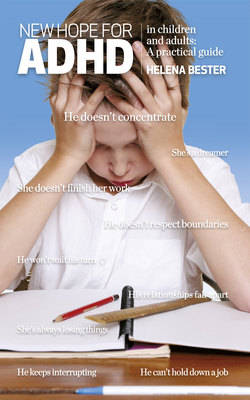Читать книгу New hope for ADHD in children and adults - Helena Bester - Страница 16
На сайте Литреса книга снята с продажи.
DSM-5 diagnostic criteria for ADHD
Оглавление1 Inattentiveness
a.The person often fails to pay close attention to detail and makes careless mistakes in school work, work or other activities (details are overlooked or omitted, for example, or the work is inaccurate).
b.The person often has difficulty sustaining attention in tasks and play activities (finds it difficult to remain focused during lectures, conversations or long reading sessions, for example).
c.The person does not seem to listen when spoken to directly (the person’s thoughts seem to be elsewhere, for instance, even in the absence of any obvious distraction).
d.The person often does not follow through on instructions and fails to finish school work, chores or duties in the work place (starts tasks but quickly loses focus and is easily distracted, for example).
e.The person often finds it difficult to organise tasks or activities (for example, difficulty managing sequential tasks; difficulty keeping materials and belongings in order; messy, disorganised work; has poor time management; fails to meet deadlines).
f.The person often avoids or is reluctant to engage in tasks that require sustained mental effort (school work or homework, for example; in older adolescents and adults, the preparation of reports, completion of forms and review of lengthy papers).
g.Items essential to the performance of tasks or activities are often lost (for example, school materials, pencils, books, tools, wallets, keys, paperwork, spectacles, cellphones).
h.The person is easily distracted by extraneous stimuli (among adolescents and adults this may include thoughts about unrelated matters).
i.Frequently forgetful in daily activities (doing chores, running errands, for example; among older adolescents and adults, the answering of calls, paying of accounts and keeping of appointments).
2 Hyperactivity and impulsivity
a.The person often fidgets or taps hands or squirms in his or her seat.
b.The person often leaves his or her seat when remaining seated is expected (leaving their seat in the classroom or office, other workplace or in other situations where they are expected to remain in one place).
c.The person runs around or climbs in situations where it is inappropriate (in adolescents or adults this behaviour may be limited to feelings of restlessness).
d.The person often has difficulty playing or engaging in leisure activities quietly.
e.The person is often “on the go” or behaves as if he or she is “driven by a motor” (for example, is unable or finds it difficult to remain still for long periods, such as in a restaurant or during meetings; others may experience this as restlessness or an inability to keep up).
f.He or she often talks excessively.
g.The person often blurts out answers before questions have been completely formulated. He or she finishes others’ sentences for them and finds it difficult to wait his or her turn to speak or contribute.
h.h. The person often finds it difficult to wait his or her turn (difficulty waiting in a queue, for instance).
i.He or she often interrupts others or intrudes on them (for example, interrupts conversations, games and activities, or uses others’ belongings without permission; adolescents and adults may intrude into or take over what others are doing).
CONDITIONS FOR THE DIAGNOSIS
Before a diagnosis of ADHD can be made in accordance with the above criteria, the following important conditions must be met:
•The symptoms must be present continuously for at least six months.
•The symptoms must be inconsistent with the person’s developmental level.
•Some of the symptoms must have started manifesting before the age of twelve.
•There must be clear evidence that the symptoms interfere with or reduce the quality of social, academic or occupational functioning.
•The symptoms must not be the result of schizophrenia or another psychotic disorder, and should not be better explained by a diagnosis of another mental disorder, for example, anxiety disorder, dissociative disorder, personality disorder or substance intoxication or withdrawal.
•Several inattentive or hyperactive-impulsive symptoms must be present in at least two environments (for example, at school or place of work, among friends and family, or during other activities).
•At least six symptoms under number 1 or six symptoms under number 2 must be present in children below the age of seventeen years. In older adolescents and adults, at least five symptoms under number 1 or five symptoms under number 2 must be present.
•The symptoms must not be due to oppositional behaviour only or due exclusively to defiance or be a result solely of hostility or failure to understand tasks or instructions.
Completing assessment questionnaires like the behavioural checklist in chapter 1, can be useful in eliminating unnecessary or incorrect diagnoses. Such a checklist should be completed by both a parent and a teacher.
According to the diagnostic criteria of the DSM-5, there are three types of ADHD:
